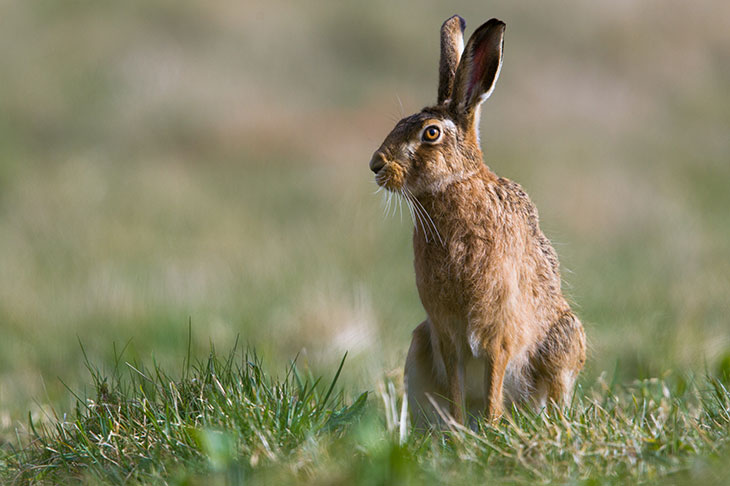If you’re driving at dawn or at dusk in the countryside at this time of year, you might well see shady-looking men standing around in a stubble field, their 4x4s parked close by and ‘long’ dogs — greyhound types — straining on the lead beside them.
Watch and you’ll see them walk up the field, or along the edges, until a hare makes a bolt for it. The men are ready. This is what they’re there for. A dog is let off the lead, and someone with a phone videos the scene. The footage is being live-streamed to others who have placed bets on the outcome —guessing which dog will kill the most hares per ‘slip’, or chase. When the hare has been caught (or when it’s scarpered), another dog has a go.
Modern-day hare coursing is illegal, but even so it’s become common in the UK, especially after harvest and in counties where the fields are flat. It’s such a significant problem that Labour this week included a pledge in their animal welfare manifesto to ‘bring in measures to effectively tackle hare coursing’, funded by £4.5 million they’ve promised to police wildlife crimes.
Hare coursing involves poaching and trespassing, and it’s aggravating and damaging to farmers — but it’s very hard for them to prevent, because of the sort of men who do it. When one hare courser’s home was raided recently, the police uncovered a stash of guns, ammunition and cannabis — as well as his coursing lurchers. These men come with muscle. Coursers often travel in convoy, with a car or van of ‘minders’ at the front and rear. Farmers who confront them get, at best, a barrage of abuse, but many have received death threats. Their barns and cars have been burnt down.
How times have changed. A century ago hare coursing was the sport of kings, not kingpins. In March 1871, one famous coursing greyhound, Master McGrath, three-times winner of the Waterloo Cup, was taken to meet Queen Victoria.
Then came the 2004 Hunting Act in England and Wales. You mostly hear about the act in reference to fox hunting — for example, on Tuesday when Boris Johnson abandoned the previous Tory pledge to a free vote on repealing it. But its stated purpose is: ‘An act to make provision about hunting wild mammals with dogs; to prohibit hare coursing; and for connected purposes.’
It was the Hunting Act that drove coursing underground, and at that point the rules of the game changed. In formal coursing events, a pair of dogs will be slipped (released) simultaneously, and chase after a hare when it runs. Hounds were traditionally awarded points for forcing the hare to turn — which they do far faster and more sharply than a greyhound. But in the gangster version of the sport, typically one dog is released at a time, and the winner is the one who can kill the most hares in a set number of slips. The rules are not set in stone, and there are even reports of men dropping dogs out of the car doors as a hare is running. Then, if they need to make a getaway, they simply scoop the dog back into the car and off they go.
Money is a huge part of illegal coursing, which means that prize dogs become very valuable assets. Julia Mulligan, chairwoman of the National Rural Crime Network, says that the dark web is used to buy and sell coursing dogs — which go for up to £20,000. One illegal event, the Fir Cup, is rumoured to have prize money of £6,000. And such contests are live-streamed, so that people can watch and bet (again, on the dark web).
The police are struggling to catch up. Last year, Cambridgeshire police -reported a 20 per cent rise in the number of hare coursing incidents, and in the five years to 2018, the number reported across Norfolk and Suffolk more than quadrupled. There have also been reports of hare coursing this year in Wiltshire, Buckinghamshire, Essex and East Lothian.
In Lincolnshire, where coursing has been rife because of the perfect, flat lie of the land, the police have learnt what works. Here, they seize dogs and keep them in kennels until the trial; coursers don’t want to lose valuable dogs. And Lincolnshire was the first force to use drones.
It’s important that the police continue to hunt the hunters. These men are nasty customers. Claire Wright, from the Country Land and Business Association, tells of one landowner who happened to shut a gate behind him as he left a field. Hare coursers spotted him, assumed he was attempting to lock them into the field, and attacked him with an iron bar, breaking his nose. They drive through hedges, gates, fences, scaring livestock and damaging crops. This is often in rural, remote areas where farmers and their families feel isolated and under attack.
As one farmer said: ‘It feels like the Wild West sometimes, because there’s no telling, when you go out, who you’re going to meet.’
Got something to add? Join the discussion and comment below.
Get 10 issues for just $10
Subscribe to The Spectator Australia today for the next 10 magazine issues, plus full online access, for just $10.
You might disagree with half of it, but you’ll enjoy reading all of it. Try your first month for free, then just $2 a week for the remainder of your first year.















Comments
Don't miss out
Join the conversation with other Spectator Australia readers. Subscribe to leave a comment.
SUBSCRIBEAlready a subscriber? Log in